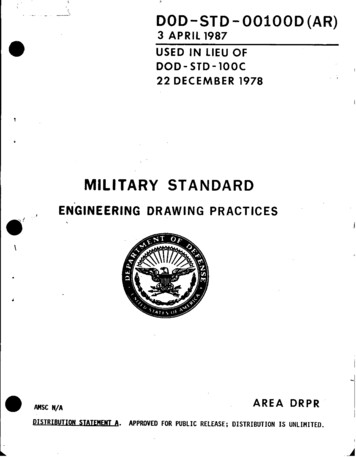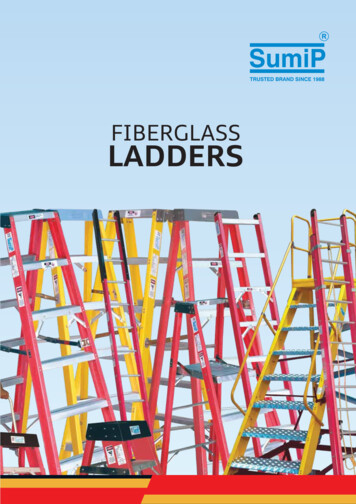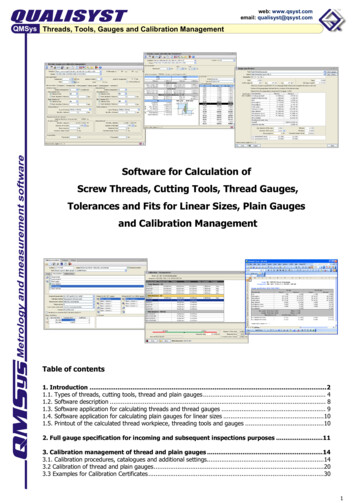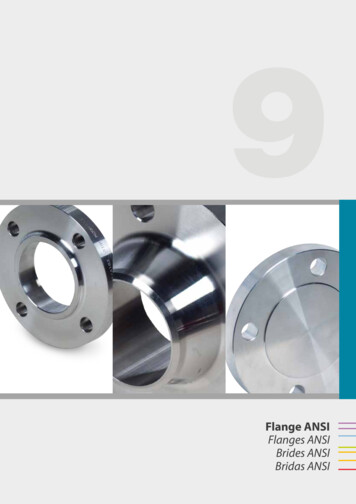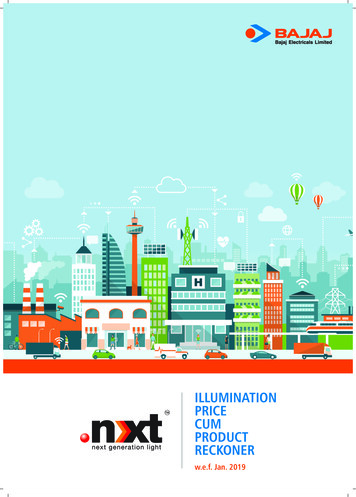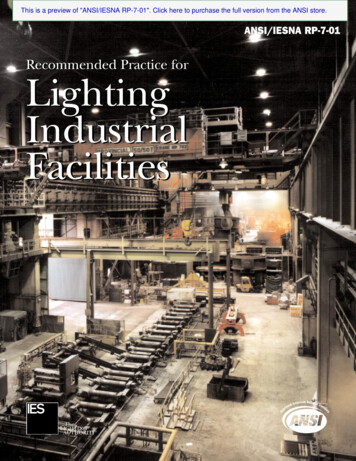
Transcription
This is a preview of "ANSI/IESNA RP-7-01". Click here to purchase the full version from the ANSI store.ANSI/IESNA RP-7-01RecommendedRecommended PracticePractice forforLightingIndustrialFacilitiesTheLIGHTING AUTHORITY
This is a preview of "ANSI/IESNA RP-7-01". Click here to purchase the full version from the ANSI store.ANSI/IESNA RP-7-01Recommended PracticeforLighting Industrial FacilitiesPublication of this CommitteeReport has been approvedby the IESNA. Suggestions forrevisions should be directedto the IESNA.Prepared by:The IESNA Industrial Lighting CommitteeCover photo courtesy of Keene-Widelite Division of Canlyte
This is a preview of "ANSI/IESNA RP-7-01". Click here to purchase the full version from the ANSI store.ANSI / IESNA RP-7-01Copyright 2001 by the Illuminating Engineering Society of North America.Approved by the IESNA Board of Directors, August 4, 2001, as a Transaction of the Illuminating EngineeringSociety of North America.Approved July 26, 2001 by the American National Standards Institute, Inc.All rights reserved. No part of this publication may be reproduced in any form, in any electronic retrieval systemor otherwise, without prior written permission of the IESNA.Published by the Illuminating Engineering Society of North America, 120 Wall Street, New York, New York 10005.IESNA Standards and Guides are developed through committee consensus and produced by the IESNA Officein New York. Careful attention is given to style and accuracy. If any errors are noted in this document, please forward them to Rita Harrold, Director Educational and Technical Development, at the above address for verificationand correction. The IESNA welcomes and urges feedback and comments.ISBN #0-87995-176-1Printed in the United States of America.
This is a preview of "ANSI/IESNA RP-7-01". Click here to purchase the full version from the ANSI store.ANSI / IESNA RP-7-01ANSI/IESNA RP-7-01LightingRecommended Practice on IndustrialPrepared by the IESNA Industrial Lighting CommitteeRP Task Force:Diarmuid McSweeney, FIES ChairC. AmickD. DeGrazioR. KnottS. MishkyD. PaulinM. RhodesG. SchaeferIndustrial Lighting CommitteeWilliam Busch, Chair 1994-99Diarmuid McSweeney, FIES Chair 2000 –C. Amick, FIESP. BeldingW. BuschK. Chen*D. DeGrazioF. DickeyD. Duzyk*J. Engle*J. Fetters*D. FinchJ. FischerJ. HuebnerG. Irvine*V. JonesR. Knott*W. Lane*P. Lanphere*S. MishkyM. Packer*D. PaulinM. RhodesG. SchaeferW. Smelser*S. ThomasR. TopalovaJ. Vlah*R. Weber**AdvisorySpecial recognition to F. Dickey for his work on the first draft of the revision of thisstandard and to P. Boyce, FIES and R. Mistrick, FIES for their contributions.DEDICATIONThe IESNA Industrial lighting Committeewould like it noted that Charles Amickcontributed greatly to the development of thisdocument. The committee, therefore,dedicates this recommended practice tothe late Charles Amick.
This is a preview of "ANSI/IESNA RP-7-01". Click here to purchase the full version from the ANSI store.ANSI / IESNA RP-7-01
This is a preview of "ANSI/IESNA RP-7-01". Click here to purchase the full version from the ANSI store.ANSI / IESNA RP-7-01CONTENTSForward . 11.0 INTRODUCTION . 12.0 LIGHTING THE INDUSTRIAL ENVIRONMENT. 12.1 General Design Considerations for Lighting Industrial Areas . 12.2 IESNA Lighting Design Guide . 23.0 QUALITY OF LIGHTING IN INDUSTRIAL FACILITIES . 23.1 Luminance and Luminance Ratios. 23.2 Modeling of Objects. 63.3 Glare and Visual Discomfort . 63.4 Material Characteristics. 73.5 Shadows . 83.6 Source/Task/Eye Geometry. 83.7 Task Visibility-Flicker and Strobe . 93.8 Color Rendering (CRI) . 103.8.1 Color Rendering Index . 103.8.2 Safety Colors . 103.9 Daylight Integration and Control. 104.0 QUANTITY OF LIGHTING IN INDUSTRIAL FACILITIES . 114.1 Illuminance – Horizontal, Vertical and Intermediate Planes. 114.1.1 Horizontal Illuminance. 114.1.2 Vertical Illuminance . 124.2 Initial and Maintained Illuminance . 124.3 Lighting System Maintenance. 135.0 GENERAL LIGHTING EQUIPMENT . 135.1 Fluorescent Systems. 135.1.1 Source Characteristics. 135.1.2 Fluorescent Luminaire Characteristics/Performance . 155.2 High Intensity Discharge Lighting Systems. 155.2.1 Metal Halide Lamps . 155.2.1.1 Pulse-Start and Ceramic Metal-Halide Lamps . 175.2.2 High Pressure Sodium (HPS) Lamps . 175.2.3 Luminaire Selection . 175.2.3.1 High-Bay Luminaires . 185.2.3.2 Low-Bay Luminaires . 185.2.3.3 Other Luminaire Types . 186.0 BALLAST ISSUES-GENERAL . 186.1 Fluorescent Ballast Issues . 196.1.1 Ballast Circuitry . 196.1.2 Electromagnetic Ballasts. 206.1.3 Electronic Ballasts . 206.1.4 Instant Start Ballasts . 206.1.5 Rapid Start Ballasts . 216.1.6 Compact Fluorescent Ballasts. 216.1.7 Dimming and Two-Level Switching Ballasts . 216.1.8 General Ballast Requirements. 21
This is a preview of "ANSI/IESNA RP-7-01". Click here to purchase the full version from the ANSI store.ANSI / IESNA RP-7-016.2 High Intensity Discharge (HID) Ballast Issues . 216.2.1 Ignitor . 236.2.2 Metal-Halide Ballasts . 236.2.3 High Pressure Sodium Ballasts. 236.2.3.1 Magnetic Regulator or Constant-Wattage Autotransformer (CWA) Ballast. 236.2.3.2 Lag or Reactor Ballast. 236.2.3.3 Lead Circuit Ballast. 246.2.4 Other HID Ballasts . 247.0 DISTRIBUTION MODES. 247.1 General Luminaire Characteristics and Performance . 247.2 Operating Considerations. 247.2.1 Electrical . 247.3 Luminaire Classifications . 248.0 BUILDING CONSTRUCTION FEATURES THAT INFLUENCELUMINAIRE SELECTION AND LUMINAIRE PLACEMENT . 269.0 LIGHTING SYSTEM ECONOMIC ANALYSIS . 2710.0 SPECIAL CONSIDERATION FACTORS . 2910.1 Lighting and Space Conditioning . 2910.2 Classified Areas . 2910.3 High Humidity or Corrosive Atmospheres . 3010.4 High Ambient Temperatures . 3010.5 Low Ambient Temperatures. 3010.6 Clean Rooms . 3010.7 Food and Drug Processing. 3111.0 GENERAL LIGHTING . 3112.0 SUPPLEMENTARY TASK LIGHTING . 3112.1 Luminaries for Supplementary Task Lighting . 3212.2 Portable Luminaries . 3212.3 Classification of Visual Tasks and Lighting Techniques. 3313.0 SPECIAL EFFECTS AND TECHNIQUES . 3313.1 Color Contrast . 3313.2 Inspection Techniques . 3314.0 EMERGENCY, SAFETY AND SECURITY LIGHTING . 3614.1 Emergency Lighting . 3614.2 Safety Lighting . 3714.3 Security Lighting . 3715.0 LIGHTING FOR SPECIFIC TASKS. 3715.1 Molding of Metal and Plastic Parts: Discussion of Lighting and Equipment Choices . 3815.1.1 Foundry Molding (Sand Casting). 3815.1.2 Molding Parts of Die-Cast Aluminum and Injection Molded Plastic. 3815.1.3 Inspection of Sand Castings. 3815.1.4 Inspection of Die-Castings and Opaque Injection Molded Plastic Parts. 3915.2 Parts Manufacturing and Assembly . 3915.3 Machining Metal Parts . 40
This is a preview of "ANSI/IESNA RP-7-01". Click here to purchase the full version from the ANSI store.ANSI / IESNA RP-7-0116.0 LIGHTING FOR SPECIFIC VISUAL TASKS . 4016.1 Convex Surfaces . 4016.2 Flat Surfaces . 4016.3 Scribed Marks. 4016.4 Center-Punch Marks . 4116.5 Concave Specular Surfaces . 4116.6 Flat Specular Surfaces . 4116.7 Convex Specular Surfaces . 4116.8 Lighting and Visibility for Specific Sheet Metal Fabrication . 4216.8.1 Punch Press . 4216.8.2 Shear . 4216.9 Lighting for Large Component Sub- and Final Assembly . 4216.10 Control Rooms . 4316.11 Warehouse and Storage Area Lighting. 4416.11.1 Types of Warehouse Area and Storage Systems. 4416.11.2 Warehouse Illuminance . 4416.11.3 Warehouse Lighting Design Considerations . 4517.0 OUTDOOR AREA LIGHTING . 4617.1 Projected Lighting Systems . 4617.2 Distributed Lighting Systems . 4617.3 Outdoor Tower Platforms, Stairways and Ladders. 4617.4 Special Equipment . 4717.5 Low Illuminance and Visual Acuity Outdoors . 47References . 47Annex A1The Basis for Deviating from Recommended Illuminances . 48Annex A2Recommended Illuminance Values (target maintained) for Industrial Lighting Design . 51Annex BPredictive Methods for Determining Visual Comfort Probability (VCP)and Unified Glare Rating (UGR) . 64Annex CAverage Illuminance Calculation: The Lumen Method . 69
This is a preview of "ANSI/IESNA RP-7-01". Click here to purchase the full version from the ANSI store.ANSI / IESNA RP-7-01
This is a preview of "ANSI/IESNA RP-7-01". Click here to purchase the full version from the ANSI store.ANSI / IESNA RP-7-01FOREWORD(This Foreword is not part of the American NationalStandard and Practice ANSI/IESNA RP-7-01.)While the objectives of this Recommended Practiceare to give a comprehensive treatment of lighting in theindustrial environment, there are many spaces in amodern industrial complex that are used for purposesother than manufacturing. These include offices, meeting, conference and reference spaces. It is suggestedthat the reader refer to the most recent version of theseother IESNA Recommended Practices and DesignGuides for the appropriate lighting recommendationsfor spaces not covered in this publication:ANSI/IESNA RP-1, Recommended Practice onOffice LightingIESNA RP-5, Recommended Practice ofDaylightingIESNA RP-20, Recommended Practice on Lightingfor Parking FacilitiesANSI/NECA/IESNA 502, Recommended Practicefor Installing Industrial Lighting SystemsIESNA DG-2, Design Guide for WarehouseLightingwarm-up periods or stroboscopic effects createdwhere rotating parts are present. The ability of thelamps to render colors accurately may have an effecton the recognition of colors or product componentsand safety colors used to protect the workers fromdangerous conditions within the work place. Manyindustrial operations take place in hostile environments, and the hardware used in these locationsmust be designed and manufactured to survive theseconditions. For these reasons, and many others,great care is required to provide an effective, efficientand readily maintainable lighting system to help modern industrial workers produce at the peak of theirability in a safe environment.2.0 LIGHTING THE INDUSTRIAL ENVIRONMENTProviding a successful lighting design for a modernindustrial facility is a complex task. In the last threedecades of the 20th century, much has been learnedabout lighting and its positive effects on the well being ofpeople. The goal of providing an efficient, reliable andeasily maintainable lighting system, making use of all ofthe knowledge available to the designer today, is a taskthat requires experience and considerable planning.1.0 INTRODUCTION2.1 General Design Considerations for LightingIndustrial AreasA well-designed lighting system can make an important contribution to the success of an industrial facility.Unfortunately, too often the lighting is treated as anafterthought during the planning and construction ofthese facilities. Great attention is paid to the physicaldimensions of the building, to the flow of the processand materials, and to production equipment.It is common that only horizontal illuminance is considered in providing an environment in which to perform industrial tasks. However, many industrial tasksdo not occur in a horizontal plane. There are manyfeatures of the lighting system, other than quantity oflight, which make a significant contribution to the efficiency of the industrial worker. Placement of the luminaries is critical to providing light of the proper quality, as well as quantity and direction, to allow fast,easy recognition of operations, which may be takingplace at high speeds in portions of productionmachinery where ambient light cannot easily penetrate. Selection of the luminaire distribution can beimportant to rendering the visual task properly whenthat task is multi-dimensional rather than flat, andwhen the task occurs in a plane other than horizontal. The operation of the light sources must be understood to ensure that the proper lamps are selected.Improper light source choice can result in difficult andpotentially dangerous conditions caused by longThe designer of an industrial lighting system shouldcarefully consider all of the following design criteriasince any single issue, or combination of several,could be important in planning a successful industrial lighting installation. (These criteria are not necessarily arranged in order of importance since prioritieswill vary for different industries or different locationswithin an industrial complex.)1. Determine the quality of illumination for the manufacturing processes involved. (See the IndustrialLighting Design Guide in Figure 1 (a) and Section3.0.)2. Determine the quantity of illumination for the manufacturing processes involved. (See the IndustrialLighting Design Guide in Figure 1 (a) and (b),Section 4.0 and Annex C.)3. Determine the lighting required for safety andensure all three conditions (quality, quantity andsafety) are properly weighed and addressed in thefinal design.4. Select listed or approved lighting equipment that willprovide the requirements of quality and quantity,including photometric characteristics, as well asthe mechanical performance required to meetinstallation and operating conditions.5. Arrange equipment so that it will be safe, easy and1
Standard and Practice ANSI/IESNA RP-7-01.) While the objectives of this Recommended Practice are to give a comprehensive treatment of lighting in the industrial environment, there are many spaces in a modern industrial complex that are used for purposes other than manufacturing.These include offices, meet-
